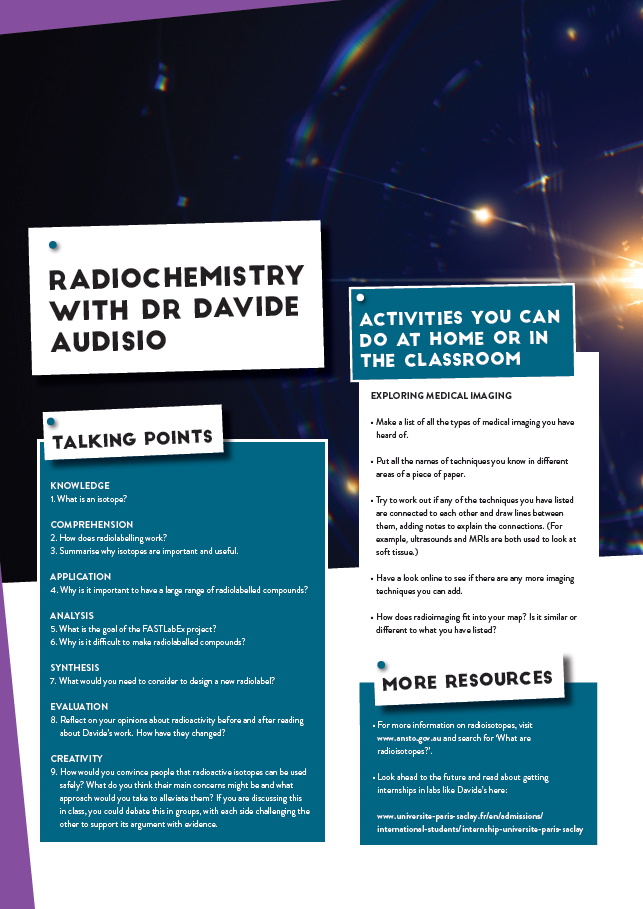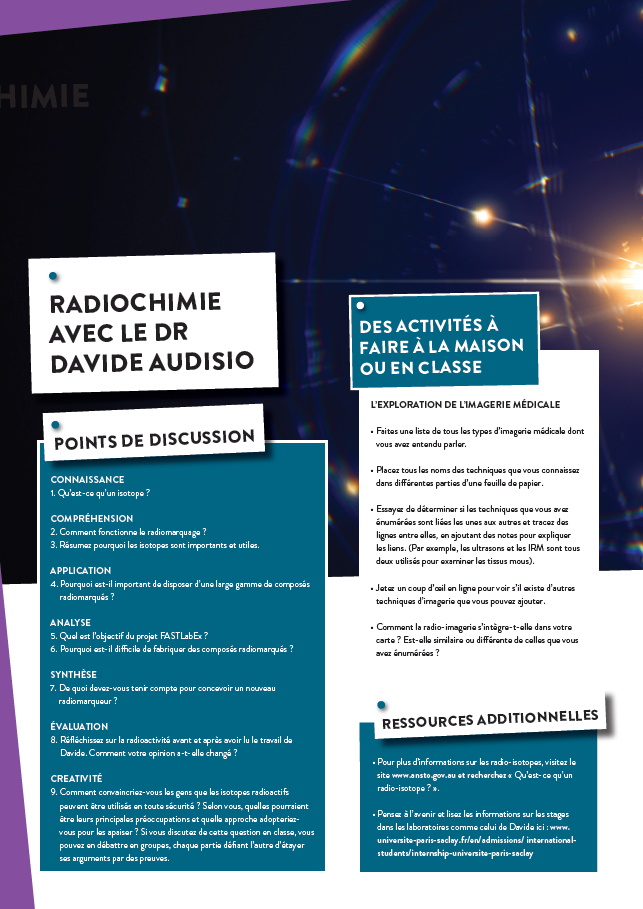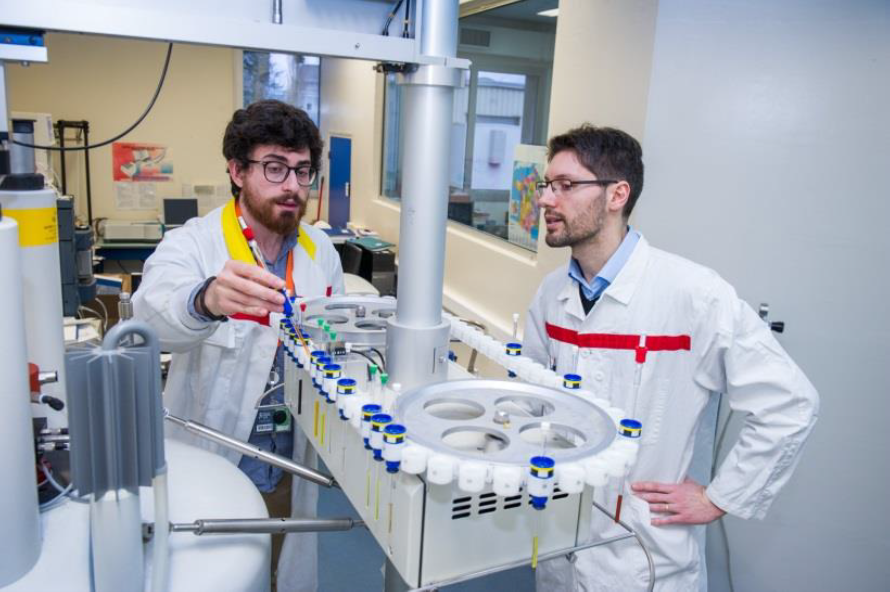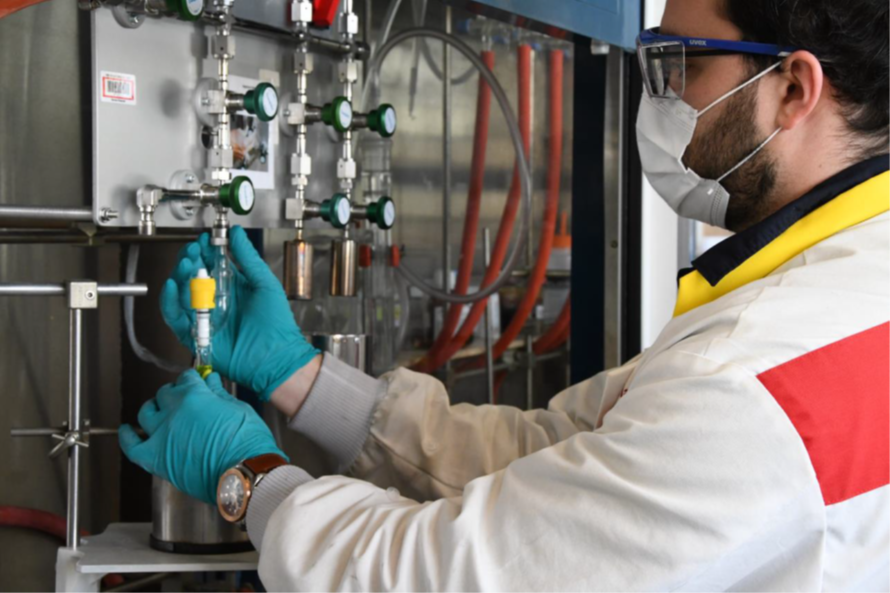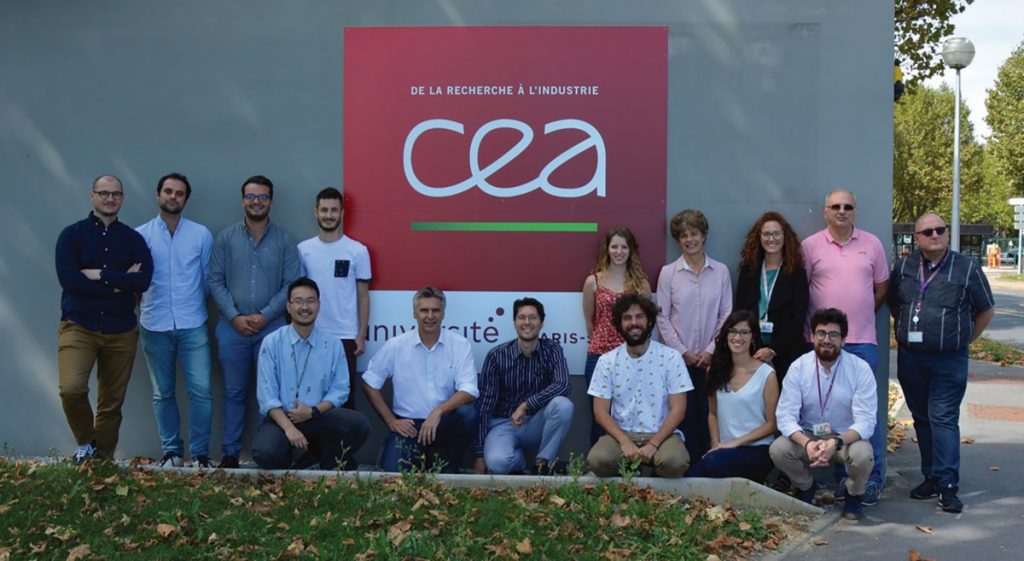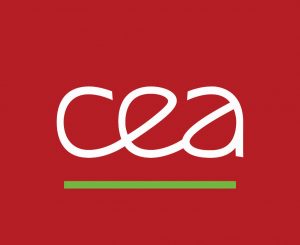How can radioactive elements help us?
Radiochemistry involves making molecules with radioactive atoms. Dr Davide Audisio of the Frédéric Joliot Institute for Life Sciences, part of the French Alternative Energies and Atomic Energy Commission, is finding new ways to use them more efficiently
TALK LIKE A RADIOCHEMIST
RADIOCHEMISTRY – the chemistry of natural and man-made unstable isotopes
ISOTOPE – variants of a chemical element that have the same number of protons but different numbers of neutrons
RADIOLABELS – the addition of a radioactive isotope to a molecule so that it can be traced and imaged
PROTONS – positively charged subatomic particles found in the nucleus of the atom
NEUTRONS – neutral particles found in the nucleus of the atom
METABOLISM – the chemical processes in cells that break down chemical compounds like food or medicine
When did you last take a tablet? Perhaps, it was when you needed to ease a headache or control an allergy? From time to time, most of us do take tablets, but how often do we think about what happens to them after we have swallowed them? More importantly, how do pharmaceutical companies assess the effects of the drugs they produce and what happens to them when they enter our bodies?
“The impact of synthetic organic molecules on health, life quality and lifestyle is beyond doubt,” says Dr Davide Audisio, of the Frédéric Joliot Institute for Life Sciences, part of The French Alternative Energies and Atomic Energy Commission (CEA), in France. “It is, therefore, of fundamental importance to detect and quantify the fate of organic compounds and provide a precise risk/benefit assessment, before they reach the market and large public exposure.”
Davide is a radiochemist whose work is evidence of the positive and profound impact the science behind radioactive materials can have on our lives. He is working on the FASTLabEX project, making molecules that contain radiolabels so that they can be traced – and so pharmaceuticals and chemicals can be developed and monitored, and safety ensured. Davide explains, “FASTLabEx will help the pharmaceutical industry to apply the new labelling methods to drugs currently in development in order to provide solutions to the most pressing problems in drug innovation.” But the impact of Davide’s work does not stop there – his project and his expertise as a radiochemist also has applications in crop science and food safety.
RADIOLABELLING
In pharmaceutical compounds, most drugs have what is called an active ingredient. The active ingredient is the molecule that has the desired medicinal effect. However, what happens between swallowing a tablet and the active ingredient entering our bloodstream and reaching its target is very complicated. This is because the molecules that we take in the tablet can be metabolised by our cells and enzymes – broken down and changed into lots of other different molecules. Hopefully, molecules will be made that have the desired healing effect. However, sometimes other compounds are made that have unwanted side effects.
When new drugs are being designed and tested for safety, Davide and many other researchers will find ways to make radiolabelled versions of the molecules. Because the chemistry in our bodies is so complex, trying to piece together what has happened is very challenging. However, a radiolabelled compound acts like a GPS for the molecule – we can work out where in the body a molecule has gone and whether it has reacted to form something new.
CARBON-14
The most common form of carbon on earth is carbon-12. Carbon-12 has six protons and six neutrons, giving an overall atomic mass number of 12. Isotopes of carbon, like carbon-14, have the same number of protons as carbon-12 but a different number of neutrons. When it comes to their chemistry, carbon-12 and carbon-14 are very alike. They will react in similar ways and can be used to make the same molecules. The key difference is that carbon-14 is radioactive and, with time, will emit radiation. This radiation can be used to track what happens with the particular element it came from. If a drug is synthesised with a radiolabel like carbon-14, researchers like Davide can follow how that drug is distributed inside a patient’s body or, in agrochemical contexts, in the environment.
THE CHALLENGES
Although radiochemistry is a powerful tool for understanding how medicines work, it can be very challenging to make radiolabelled compounds. In the natural world, carbon-14 is a trillion times less common than carbon-12. That means the probability of finding carbon-14 in the pharmaceutical molecule of interest naturally is nearly zero. Fortunately for radiochemists like Davide, carbon-14 can be made. Nuclear reactors are not just for energy but can also be used to produce the radioisotopes we use for medical imaging as well.
This makes carbon-14 a very expensive element to use and so Davide needs to be very efficient and effective in how he makes molecules containing his radiotracer. As part of the EU-funded project, FASTLabEx, he is working on new strategies to add radiolabels to molecules.
A FAST STRATEGY
Normally, to synthesise a molecule with a radiolabel, the carbon-14 source would be included at the beginning of the process, which is very inefficient and generates radioactive waste. What Davide is trying to do is to add the radiolabel to a molecule that has already been made – using a phenomenon called ‘carbon isotope exchange’.
Carbon is not the only element with isotopes. Hydrogen also has several, including deuterium and tritium. Tritium is much more common than carbon-14 and one way to radiolabel compounds with tritium is to shake the molecule in T2 – a molecule hydrogen gas where both hydrogens have been replaced with tritium, in presence of a catalyst. The tritium in the heavy hydrogen will then exchange with the hydrogens on the molecule, making the radiolabelled version.
Unfortunately, swapping carbon-12 for carbon-14 is not quite so straightforward. Davide’s idea is to take carbon-carbon bonds in a finished molecule and come up with new ways to break that one bond and swap a carbon-12 for a carbon-14. While this might sound easy, targeting the right bonds and doing this in a single step needs some highly sophisticated chemistry tricks.
If Davide and his colleagues are able to overcome this, the potential impact of FASTLabEx is huge. It would mean radiolabelled compounds could be made in a day, rather than weeks or months. With current methods, it costs 25 000 Euros for less than a gram of radiolabelled carbon dioxide. In addition, a lot of the carbon-14 is lost in the complex, multi-step synthesis, producing radioactive waste along the way.
Radiochemists like Davide play a very important role in helping medicinal chemists design and develop effective medicines. They also help produce other radioisotopes of elements like iodine, which are used to treat many thyroid disorders. Davide’s project will also help chemists all over the world learn new ways to make and break very specific carbon bonds, meaning even more exciting molecules can be made.
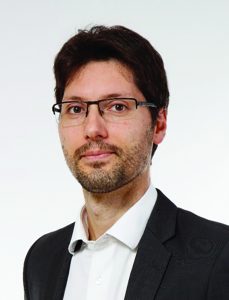 DR DAVIDE AUDISIO
DR DAVIDE AUDISIO
Research Scientist, Frédéric Joliot Institute for Life Sciences, The French Alternative Energies and Atomic Energy Commission (CEA), France
FIELD OF RESEARCH: Radiochemistry
RESEARCH PROJECT: Developing FASTLabEx, a novel technique to synthesise radiolabelled molecules
FUNDERS: The European Union
ABOUT RADIOCHEMISTRY
Radiochemistry is the study of radioactive materials. Most of the elements in the periodic table have several isotopes and many of these are radioactive. Radiochemists work with those isotopes in a variety of different ways.
Some radiochemists, like Davide, are working to synthesise molecules with radioactive isotopes in them. While this is similar in some ways to the job of a synthetic chemist in a pharmaceutical company or university, these molecules are much more complicated to work with and radiochemists need to be trained in how to handle radioactive materials.
Other researchers work with archaeologists or oceanographers who use the information from radioisotopes to age objects and track how the ocean moves. Their work differs to Davide’s as they measure the radioactivity but do not need to do chemistry with the radioelement. Some may work in hospitals, using different isotopes to help treat patients, and some may work at nuclear reactors, helping to find safe ways to deal with waste or make new isotopes.
Radiochemistry is a diverse field and many other professions rely on the knowledge and skills of radiochemists to support their work.
WHAT DOES DAVIDE FIND MOST FASCINATING/REWARDING ABOUT CHEMISTRY?
“The ability to construct organic molecules by creating and breaking new bonds is a very charming concept to me. The idea of being able to imitate nature is fascinating. For me, the most rewarding thing about chemistry is the teamwork involved. I have the privilege of working with a very talented group of people. Interacting with my colleagues is very enriching and constructive. I love when we find new ideas and solutions over these discussions.”
WHAT ISSUES WILL BE FACING THE NEXT GENERATION OF CHEMISTS?
Reference
https://doi.org/10.33424/FUTURUM164
RADIOCHEMISTRY – the chemistry of natural and man-made unstable isotopes
ISOTOPE – variants of a chemical element that have the same number of protons but different numbers of neutrons
RADIOLABELS – the addition of a radioactive isotope to a molecule so that it can be traced and imaged
PROTONS – positively charged subatomic particles found in the nucleus of the atom
NEUTRONS – neutral particles found in the nucleus of the atom
METABOLISM – the chemical processes in cells that break down chemical compounds like food or medicine
When did you last take a tablet? Perhaps, it was when you needed to ease a headache or control an allergy? From time to time, most of us do take tablets, but how often do we think about what happens to them after we have swallowed them? More importantly, how do pharmaceutical companies assess the effects of the drugs they produce and what happens to them when they enter our bodies?
“The impact of synthetic organic molecules on health, life quality and lifestyle is beyond doubt,” says Dr Davide Audisio, of the Frédéric Joliot Institute for Life Sciences, part of The French Alternative Energies and Atomic Energy Commission (CEA), in France. “It is, therefore, of fundamental importance to detect and quantify the fate of organic compounds and provide a precise risk/benefit assessment, before they reach the market and large public exposure.”
Davide is a radiochemist whose work is evidence of the positive and profound impact the science behind radioactive materials can have on our lives. He is working on the FASTLabEX project, making molecules that contain radiolabels so that they can be traced – and so pharmaceuticals and chemicals can be developed and monitored, and safety ensured. Davide explains, “FASTLabEx will help the pharmaceutical industry to apply the new labelling methods to drugs currently in development in order to provide solutions to the most pressing problems in drug innovation.” But the impact of Davide’s work does not stop there – his project and his expertise as a radiochemist also has applications in crop science and food safety.
RADIOLABELLING
In pharmaceutical compounds, most drugs have what is called an active ingredient. The active ingredient is the molecule that has the desired medicinal effect. However, what happens between swallowing a tablet and the active ingredient entering our bloodstream and reaching its target is very complicated. This is because the molecules that we take in the tablet can be metabolised by our cells and enzymes – broken down and changed into lots of other different molecules. Hopefully, molecules will be made that have the desired healing effect. However, sometimes other compounds are made that have unwanted side effects.
When new drugs are being designed and tested for safety, Davide and many other researchers will find ways to make radiolabelled versions of the molecules. Because the chemistry in our bodies is so complex, trying to piece together what has happened is very challenging. However, a radiolabelled compound acts like a GPS for the molecule – we can work out where in the body a molecule has gone and whether it has reacted to form something new.
CARBON-14
The most common form of carbon on earth is carbon-12. Carbon-12 has six protons and six neutrons, giving an overall atomic mass number of 12. Isotopes of carbon, like carbon-14, have the same number of protons as carbon-12 but a different number of neutrons. When it comes to their chemistry, carbon-12 and carbon-14 are very alike. They will react in similar ways and can be used to make the same molecules. The key difference is that carbon-14 is radioactive and, with time, will emit radiation. This radiation can be used to track what happens with the particular element it came from. If a drug is synthesised with a radiolabel like carbon-14, researchers like Davide can follow how that drug is distributed inside a patient’s body or, in agrochemical contexts, in the environment.
THE CHALLENGES
Although radiochemistry is a powerful tool for understanding how medicines work, it can be very challenging to make radiolabelled compounds. In the natural world, carbon-14 is a trillion times less common than carbon-12. That means the probability of finding carbon-14 in the pharmaceutical molecule of interest naturally is nearly zero. Fortunately for radiochemists like Davide, carbon-14 can be made. Nuclear reactors are not just for energy but can also be used to produce the radioisotopes we use for medical imaging as well.
This makes carbon-14 a very expensive element to use and so Davide needs to be very efficient and effective in how he makes molecules containing his radiotracer. As part of the EU-funded project, FASTLabEx, he is working on new strategies to add radiolabels to molecules.
A FAST STRATEGY
Normally, to synthesise a molecule with a radiolabel, the carbon-14 source would be included at the beginning of the process, which is very inefficient and generates radioactive waste. What Davide is trying to do is to add the radiolabel to a molecule that has already been made – using a phenomenon called ‘carbon isotope exchange’.
Carbon is not the only element with isotopes. Hydrogen also has several, including deuterium and tritium. Tritium is much more common than carbon-14 and one way to radiolabel compounds with tritium is to shake the molecule in T2 – a molecule hydrogen gas where both hydrogens have been replaced with tritium, in presence of a catalyst. The tritium in the heavy hydrogen will then exchange with the hydrogens on the molecule, making the radiolabelled version.
Unfortunately, swapping carbon-12 for carbon-14 is not quite so straightforward. Davide’s idea is to take carbon-carbon bonds in a finished molecule and come up with new ways to break that one bond and swap a carbon-12 for a carbon-14. While this might sound easy, targeting the right bonds and doing this in a single step needs some highly sophisticated chemistry tricks.
If Davide and his colleagues are able to overcome this, the potential impact of FASTLabEx is huge. It would mean radiolabelled compounds could be made in a day, rather than weeks or months. With current methods, it costs 25 000 Euros for less than a gram of radiolabelled carbon dioxide. In addition, a lot of the carbon-14 is lost in the complex, multi-step synthesis, producing radioactive waste along the way.
Radiochemists like Davide play a very important role in helping medicinal chemists design and develop effective medicines. They also help produce other radioisotopes of elements like iodine, which are used to treat many thyroid disorders. Davide’s project will also help chemists all over the world learn new ways to make and break very specific carbon bonds, meaning even more exciting molecules can be made.
 DR DAVIDE AUDISIO
DR DAVIDE AUDISIO
Research Scientist, Frédéric Joliot Institute for Life Sciences, The French Alternative Energies and Atomic Energy Commission (CEA), France
FIELD OF RESEARCH: Radiochemistry
RESEARCH PROJECT: Developing FASTLabEx, a novel technique to synthesise radiolabelled molecules
FUNDERS: The European Union
ABOUT RADIOCHEMISTRY
Radiochemistry is the study of radioactive materials. Most of the elements in the periodic table have several isotopes and many of these are radioactive. Radiochemists work with those isotopes in a variety of different ways.
Some radiochemists, like Davide, are working to synthesise molecules with radioactive isotopes in them. While this is similar in some ways to the job of a synthetic chemist in a pharmaceutical company or university, these molecules are much more complicated to work with and radiochemists need to be trained in how to handle radioactive materials.
Other researchers work with archaeologists or oceanographers who use the information from radioisotopes to age objects and track how the ocean moves. Their work differs to Davide’s as they measure the radioactivity but do not need to do chemistry with the radioelement. Some may work in hospitals, using different isotopes to help treat patients, and some may work at nuclear reactors, helping to find safe ways to deal with waste or make new isotopes.
Radiochemistry is a diverse field and many other professions rely on the knowledge and skills of radiochemists to support their work.
WHAT DOES DAVIDE FIND MOST FASCINATING/REWARDING ABOUT CHEMISTRY?
“The ability to construct organic molecules by creating and breaking new bonds is a very charming concept to me. The idea of being able to imitate nature is fascinating. For me, the most rewarding thing about chemistry is the teamwork involved. I have the privilege of working with a very talented group of people. Interacting with my colleagues is very enriching and constructive. I love when we find new ideas and solutions over these discussions.”
WHAT ISSUES WILL BE FACING THE NEXT GENERATION OF CHEMISTS?
“The next generation of chemists will have to face a series of challenges. In organic chemistry, there are still plenty of unsolved fundamental problems. In particular, they will need to find new solutions for making chemicals that will be environmentally friendly – they will need to harness ‘green chemistry’.”
DOES THE FRÉDÉRIC JOLIOT INSTITUTE FOR LIFE SCIENCES OFFER ANY PUBLIC OUTREACH SCHEMES?
“One of our duties at CEA is to teach our expertise to young people and so we regularly have internship programmes with students. These can vary in format: programme lengths range from a short period of two weeks for high school students, to 6 months for master’s students.”
EXPLORE A CAREER IN RADIOCHEMISTRY
• Radiochemistry and nuclear chemistry are closely related. While direct work experience in radiochemistry may be difficult to get, you may be able to visit the nuclear medicine department of your local hospital or your local university.
• According to payscale.com, the average salary for a radiochemist in the UK is £37,000.
• According to salarylist.com, the average salary for a radiochemist in the US is around $62,000.
Most radiochemists will have a bachelor’s degree in chemistry or physics, with some having a degree in engineering. Having a relevant master’s and PhD may also be useful. As the worldwide demand for radioisotopes increases, radiochemistry is likely to be an in-demand area in the future.
• Radiochemistry is often not extensively covered during a bachelor’s degree but a strong background in chemistry, maths and physics will help.
• Research experience, even in a different field, may be useful for many jobs in radiochemistry, as well as strong laboratory and data analysis skills. A good understanding of safety procedures is mandatory!
HOW DID DAVIDE BECOME A RADIOCHEMIST?
WHO OR WHAT INSPIRED YOU TO BECOME A SCIENTIST?
When I was young, I said that I wanted to be a scientist, without really understanding the implications of what that meant! My father was trained as a chemist and this probably influenced me more than I realised. I have been blessed with excellent supervisors during my studies and work, who have played a major role for me, and have been and still are an invaluable source of inspiration.
WHAT WERE YOUR INTERESTS AS A CHILD?
I was very passionate about sports. Soccer and basketball were two of my favourites. At school, I was always more interested in scientific topics.
WHAT ATTRIBUTES HAVE MADE YOU SUCCESSFUL AS A SCIENTIST?
Passion, curiosity and motivation.
HOW DO YOU OVERCOME OBSTACLES IN YOUR WORK?
I try to stay focused and think outside of the box. Interaction and discussion with my colleagues can be very helpful, as well.
WHAT ARE YOUR PROUDEST CAREER ACHIEVEMENTS?
My proudest career achievements are related to the impact I might have on my students. To see them grow and mature as scientists over the time they spend with us and help them shape their future careers is highly rewarding.
DAVIDE’S TOP TIPS
01 Take advantage of opportunities to see new things, including exchange programmes. Having the opportunity to see new laboratories or countries can be really enriching and help broaden your horizons.
02 Talk about your scientific problems with others – this can be an excellent way of gaining new insights and figuring things out.
03 Do what you are most passionate about. Follow your own path.
Do you have a question for Davide?
Write it in the comments box below and Davide will get back to you. (Remember, researchers are very busy people, so you may have to wait a few days.)



